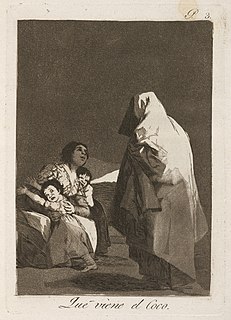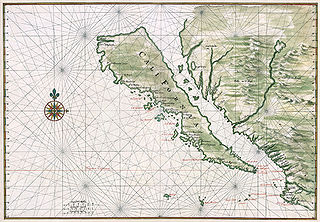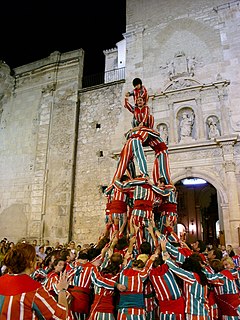 W
WAccording to Catholic tradition, Saint Amaro or Amarus the Pilgrim was an abbot and sailor who it was claimed sailed across the Atlantic Ocean to an earthly paradise. There are two historical figures who may have provided the basis for this legend. The first was a French penitent of the same name who went on a pilgrimage to Santiago de Compostela in the thirteenth century. On his return journey, he established himself at Burgos, where he founded a hospital for lepers.
 W
WA Cantabrian albarca is a rustic wooden shoe in one piece, which has been used particularly by the peasants of Cantabria, northern Spain. In the neighbouring province of Asturias madreñas are still being widely used in rural areas, and have been used for millennia.
 W
WThe Coco or Coca is a mythical ghost-monster, equivalent to the bogeyman, found in many Hispanic or Spanish speaking countries. It can also be considered an Iberian version of a bugbear as it is a commonly used figure of speech representing an irrational or exaggerated fear. The Cucuy is a male being while Cuca is a female version of the mythical monster. The "monster" will come to the house of disobedient children and make them "disappear".
 W
WCostumbrismo is the literary or pictorial interpretation of local everyday life, mannerisms, and customs, primarily in the Hispanic scene, and particularly in the 19th century. Costumbrismo is related both to artistic realism and to Romanticism, sharing the Romantic interest in expression as against simple representation and the romantic and realist focus on precise representation of particular times and places, rather than of humanity in the abstract. It is often satiric and even moralizing, but unlike mainstream realism does not usually offer or even imply any particular analysis of the society it depicts. When not satiric, its approach to quaint folkloric detail often has a romanticizing aspect.
 W
WA duende is a humanoid figure of folklore, with variations from Iberian, Ibero American, and Filipino cultures, comparable to dwarves, gnomes, or leprechauns. In Spanish duende originated as a contraction of the phrase dueño de casa or duen de casa, effectively "master of the house", or perhaps derived from some similar mythical being of the Visigoth or Swabian culture given its similarity with the “Tomte” of the Swedish language conceptualized as a mischievous spirit inhabiting a dwelling.
 W
WEmber days are quarterly periods of prayer and fasting in the liturgical calendar of Western Christian churches. These fasts traditionally take place on the Wednesday, Friday, and Saturday following St Lucy's Day, the first Sunday in Lent, Pentecost (Whitsun), and Holy Cross Day, though some areas follow a different pattern. Ordination ceremonies are often held on Ember Saturdays or the following Sunday.
 W
WThe Festivity of La Mare de Déu de la Salut is a festival celebrated in Algemesí, Spain, from August 29 to September 8. The festival is in honour of the patron saint of Algemesí, La Mare de Déu de la Salut, and has been dated back to 1247. The holiday was awarded the UNESCO "Masterpieces of the Oral and Intangible Heritage of Humanity" designation on November 28, 2011.
 W
WPatufet is the main character of one of the most famous folktales of Catalan tradition.
 W
WThe Island of California refers to a long-held European misconception, dating from the 16th century, that the Baja California Peninsula was not part of mainland North America but rather a large island separated from the continent by a strait now known as the Gulf of California.
 W
WLas Hurdes is a comarca in the Sistema Central, at the northern end of the province of Cáceres in the Autonomous Community of Extremadura, Spain. A well-known historical region, Las Hurdes is currently a Site of Community Importance of the European Union.
 W
WThe Lovers of Teruel is a romance story that is alleged to have taken place in 1217 in the city of Teruel (Aragón).
 W
WMilagros are religious folk charms that are traditionally used for healing purposes and as votive offerings in Mexico, the southern United States, other areas of Latin America, and parts of the Iberian peninsula. They are frequently attached to altars, shrines, and sacred objects found in places of worship, and they are often purchased in churches and cathedrals, or from street vendors.
 W
WThe Muixeranga is the collective name given to the performance of ancient street dances and human pyramids or castells, originating in the ancient Kingdom of Valencia, which are still preserved in the town of Algemesí, 30 km (19 mi) southwest from Valencia, and certain other Valencian towns.
 W
WGarci Rodríguez de Montalvo was a Castilian author who arranged the modern version of the chivalric romance Amadis of Gaul. Originally written in three books in the 14th century by an unknown author, Montalvo incorporated a fourth book in the original series, and followed it with a sequel, Las sergas de Esplandián. It is the sequel that Montalvo is most often noted for, not for the book itself, but because within the book he coined the word California.
 W
WThe Sack Man is a figure similar to the bogeyman, portrayed as a man with a sack on his back who carries naughty children away. Variants of this figure appear all over the world, particularly in Latin countries, such as Spain, Portugal, and the countries of Latin America, where it referred to as el "Hombre del costal", el hombre del saco, or in Portuguese, o homem do saco, and Eastern Europe. Similar legends are found in Haiti and some countries in Asia.
 W
WThe Wild Hunt is a folklore motif that historically occurs in the folklore of various northern European cultures. Wild Hunts typically involve a "soul-raving" chase led by a mythological figure escorted by a ghostly or supernatural group of hunters passing in wild pursuit. The leader of the hunt is often a named figure associated with Odin in Germanic legends, but may variously be a historical or legendary figure like Theodoric the Great, the Danish king Valdemar Atterdag, the Welsh psychopomp Gwyn ap Nudd, biblical figures such as Herod, Cain, Gabriel, or the Devil, or an unidentified lost soul or spirit either male or female. The hunters are generally the souls of the dead or ghostly dogs, sometimes fairies, Valkyries, or elves.